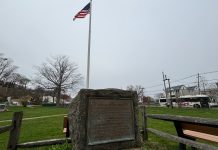By Mary Ann Bourbeau
ASBURY PARK – Grand Central Station, with its glorious main concourse and Beaux-arts façade, may be getting a lot of attention in 2013 as it celebrates its 100th year. But there is a trio of treasures in Asbury Park that was designed by the same architectural firm.
Warren and Wetmore brought its vision to the historic shore resort when they built the Paramount Theatre, Grand Arcade and Convention Hall.

Hopefully, those buildings will continue to draw tourists for another 100 years, but right now their future is uncertain. In 2007 Madison Marquette, a real estate investment firm, signed on to bring back the original splendor of the complex. While many structural and aesthetic improvements have been made, the 2011 deadline to install a state-mandated sprinkler system has long passed. Madison Marquette now says the cost, in excess of $1 million, is prohibitive, especially after Super Storm Sandy caused more than $1 million in damage. An agreement reached with the city allows the firm to forego installing sprinklers and close the building if continued operation of the complex is not economically feasible.
“We are engaged in conversations with city officials on this issue, and are hopeful that we can find a way to modify how the building is currently used, comply with all code requirements and continue to keep some or most of this great building open to the public,” said Anselm Fusco, senior vice president of Madison Marquette.
Pending the outcome of these conversations, no events have been scheduled in the complex after May 1.
Since signing on to rebuild Asbury Park’s waterfront, Madison Marquette took on the daunting task of bringing the Paramount back to the splendor that Warren and Wetmore designed. The company made significant restorations to the historical details both inside and out. The crumbling plaster was repaired and the leaky domed ceiling was brought back to its original grandeur. Ripped seating was replaced, technical and mechanical systems were brought up to date and ornamentation was refurbished. Upgrades were made to the plumbing and air conditioning in Convention Hall, and portions of its architectural glory were restored.
“When you walk through these buildings, you are taken aback by their beauty,” Fusco said. “There are even design details in areas not seen by the public, and that speaks volumes to the craftsmanship that went into these iconic buildings.”
The design started with Whitney Warren, a cousin of the Vanderbilts, who studied architecture in Paris and loved the city so much he lived there for 10 years. When he returned to New York in 1896, he partnered with Harvard graduate Charles Wetmore to form the Warren and Wetmore architectural firm. They first gained prominence when they designed the New York Yacht Club in 1900.
Their first high-profile commission was Grand Central Station, which opened in 1913. Their vision brought about the Steinway, Helmsley and Crown buildings; Chelsea Piers; St. James Theater; and the Biltmore, Ritz-Carlton and Vanderbilt hotels in New York.
They also designed Michigan Central Railroad, the Ritz-Carlton in Atlantic City and the Louvain Library in Belgium, which was destroyed by the Germans during World War I, according to New York Architecture’s website.

Meanwhile, back in Asbury Park, a group of local businessmen, hotel owners and city officials toyed with the idea of building a 5,000-seat structure along the boardwalk, but the $500,000 price tag proved too costly. According to the National Register of Historic Places, 10 years passed before any further action was taken and by then, building estimates had quadrupled. By the time Warren and Wetmore submitted their bid in 1927, the cost was more than $3 million, according to the National Register of Historic Places. But the plan was approved in the hopes it would help to draw even more tourists to the tony shore resort.
“Asbury Park was the upper echelon of the social circle, so I’m sure they were used to the best,” said Angie Sugrim, promotion specialist for Madison Marquette. The complex, which was completed in 1930, was designed in Italian and French themes with an emphasis on nautical motifs.
In the 1,600-seat Paramount Theatre, one can’t help but notice the sea serpents, mermaids and shell designs in the ironwork, on the seats and on the painted dome ceiling. The outside brickwork features scallop shells and other nautical artwork. Several large copper schooners and lanterns are positioned high up on the balconies. Many of the molds that were used for the plaster work are still in the theater, readily available for use in future renovations.
“A lot of care went into designing this place,” said Brandon Vaught, maintenance supervisor for the complex. “I like how every day I find something new in the details.”
High up in the rafters is the projection area, where five original film projectors, each 6-feet tall by 6-feet long, sit dusty and untouched. Graffiti signatures fill the concrete walls, some from recent acts that have graced the stage, including the Bouncing Souls and Blue October, and others that date back to the 1930s. Musicians must love the acoustics that Warren and Wetmore included in the domed theater because even today, it provides superior sound for the artists. Sugrim said that during a performance a few years ago, Tony Bennett demonstrated this by singing a song to the audience without a microphone.
“The Paramount was built with the idea that the room had to amplify itself,” she said.
Rumors run rampant that the buildings are haunted. Some say the ghosts are victims of the S.S. Morro Castle, a cruise ship that once sailed between New York and Havana. On Sept. 8, 1934, the ship caught fire and came to rest on a sandbar in front of Convention Hall. Many of the 137 victims were brought inside the auditorium. Others think the hauntings could be the spirits of two cabaret showgirls who died in a dressing room fire in the Paramount Theatre many years ago. Dressing room No. 8, down at the end of a long, narrow hallway, remains in its burned-out state and the door is always kept locked.
“The buildings are definitely haunted,” Sugrim said. “We all hear things, and some of us see things.”
The Grand Arcade features restaurants and shops that sell shore decorations, jewelry and Asbury Park memorabilia. It connects The Paramount Theatre, which faces Ocean Avenue, and Convention Hall, located on the beach side.

The grandeur of the Paramount design is missing from Convention Hall, but it still has a personality of its own. It was once home to a 700-pipe Kilgen organ, which was used to provide accompaniment for silent movies. Winged seahorse designs can be seen when entering the auditorium, which holds 3,600 people and hosts various events such as concerts, sporting events, tattoo festivals, fishing flea markets and roller derbies.
“It’s nice to have a big room like this and make it into whatever you want,” Sugrim said.
The nautical theme runs throughout Convention Hall, with two long paintings on either side of the stage featuring striped bass and jellyfish in an ocean scene. Though the water in the paintings is not real, the water that flowed in from Super Storm Sandy was. The basements of all three buildings, where all of the electrical panels are located, were completely flooded and about a foot of water covered the ground floors. The roof and arcade doors sustained damage, beachside stairs separated and sand was piled 5 feet high in the Grand Arcade.
“Relatively speaking, we had a lot less damage than the rest of the shore,” Sugrim said.














